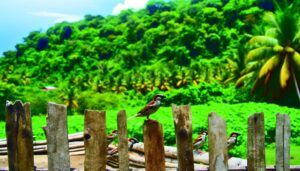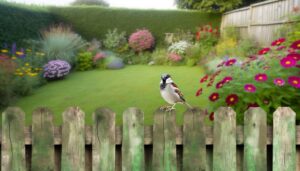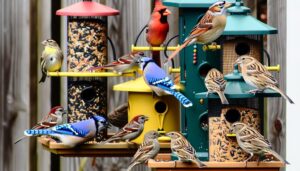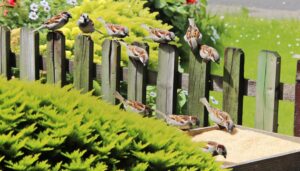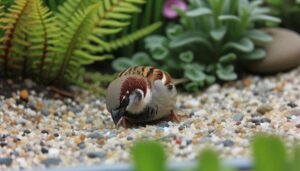5 Simple Steps to Trap House Sparrows Effectively
To effectively trap house sparrows, start by understanding their opportunistic feeding and territorial behaviors. Opt for funnel traps in open spaces or repeating traps in dense areas.
Inspect, clean, and assemble traps carefully to enhance functionality. Use preferred bait such as millet seeds, cracked corn, and sunflower seeds, placing it near feeding grounds or nesting sites.
Position traps in urban or suburban environments with moderate human activity. Regularly inspect traps, maintain bait quality, and adjust based on sparrow activity.
Safe release practices, like relocating sparrows 10 miles away, ensure ethical management. For a thorough approach, additional insights will follow.
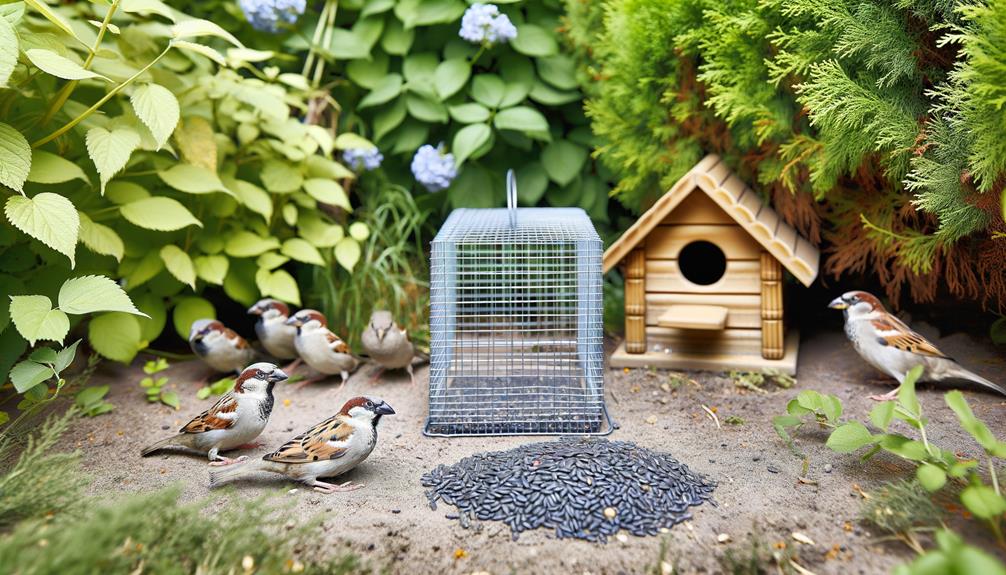
Key Takeaways
- Use funnel traps in open spaces and repeating traps in high-density areas for effective sparrow trapping.
- Position traps near feeding grounds, nesting sites, or bird feeders to increase capture rates.
- Bait traps with millet seeds, cracked corn, breadcrumbs, or sunflower seeds for optimal attraction.
- Regularly inspect and replenish bait to maintain trap effectiveness and attractiveness to sparrows.
- Utilize decoys or recorded sparrow calls to lure sparrows into traps strategically.
Understanding Sparrow Behavior
Understanding sparrow behavior requires an in-depth examination of their feeding habits, territoriality, and social interactions. All of these aspects are essential for devising effective trapping strategies.
House sparrows (Passer domesticus) exhibit opportunistic feeding patterns, often foraging in areas with abundant seeds and grains. Their territorial behavior is characterized by aggressive defense of nesting sites, especially during the breeding season.
Social interactions within sparrow flocks reveal a complex hierarchy that influences access to resources. Studies indicate that sparrows are more likely to be trapped near their preferred feeding grounds or nesting sites.
Moreover, their social nature can be leveraged by using decoys or recorded calls to attract them to traps. Understanding these behavioral nuances is crucial for implementing successful trapping programs.
Choosing the Right Trap
Selecting the appropriate trap for capturing house sparrows requires careful consideration of trap design, efficacy, and suitability for the targeted environment. Research indicates that different trap types exhibit variable success rates, influenced by factors such as location and sparrow behavior. The table below summarizes key characteristics of three common trap types to aid in decision-making:
| Trap Type | Design Features | Efficacy Rate (%) |
|---|---|---|
| Funnel Trap | Conical entrance, mesh sides | 70 |
| Repeating Trap | Multiple entrance slots, holding chamber | 85 |
| Larsen Trap | Cage structure, decoy compartment | 60 |
Selecting a trap should be guided by specific environmental conditions and target population density. Funnel traps are ideal for open spaces, while repeating traps function effectively in high-density areas. Meanwhile, Larsen traps are suitable for strategic decoy use.
Preparing the Trap
Properly preparing the trap involves maximizing all components to function well, be clean, and strategically positioned to maximize capture success. Careful preparation enhances the trap's effectiveness and minimizes the potential for sparrows to evade capture.
Critical preparations include:
- Inspection: Examine the trap for any damage, making sure all parts operate smoothly.
- Sanitization: Clean the trap thoroughly to remove any residue or odors that may deter sparrows.
- Assembly: Ensure the trap is correctly assembled, with all mechanisms working as intended.
- Placement: Position the trap in areas frequented by house sparrows, such as near bird feeders or nesting sites.
Adhering to these steps ensures the trap is well-prepared for effective sparrow capture, laying the foundation for subsequent baiting strategies.
Baiting Techniques
The effectiveness of trapping house sparrows is greatly influenced by the choice of bait and its strategic placement. Research indicates that seeds, especially millet, serve as very attractive bait due to the dietary preferences of these birds.
Best bait placement involves situating the bait in a manner that encourages sparrows to enter the trap while minimizing access for non-target species.
Choosing Effective Bait
When selecting effective bait for trapping house sparrows, it is important to take into account the birds' dietary preferences and local foraging behaviors to maximize trap success. Research indicates that house sparrows are granivorous, favoring seeds and grains.
Monitoring local birds can reveal specific preferences that enhance bait effectiveness. Recommended bait options include:
- Millet seeds: Highly attractive due to their small size and nutritional content.
- Cracked corn: Visible and readily consumed by house sparrows.
- Breadcrumbs: Common, easily accessible food source in urban environments.
- Sunflower seeds: Particularly effective when other food sources are scarce.
Understanding these preferences allows for tailored bait selection, improving the likelihood of trap engagement and successful capture.
Optimal Bait Placement
Strategic bait placement greatly influences the success rate of trapping house sparrows, necessitating a thorough understanding of their feeding patterns and habitat use. Research indicates that house sparrows frequent areas abundant in food sources, such as near bird feeders, agricultural fields, and urban environments. Placing bait in these high-activity zones significantly enhances trapping efficacy.
Observational studies suggest positioning bait at ground level or slightly elevated surfaces, mimicking natural foraging conditions. Additionally, clustering bait within trap confines ensures sparrows encounter it during their routine search for food. Regularly inspecting and replenishing bait maintains attraction and trap functionality.
Therefore, precise bait placement, informed by behavioral insights, is pivotal for effective sparrow trapping, optimizing capture rates while minimizing non-target interference.
Setting Up the Trap
Setting up the trap for house sparrows requires careful consideration of the trap location. It should be in areas of high sparrow activity such as feeding sites or nesting areas. The selection of bait is essential and must align with the dietary preferences of house sparrows, typically involving grains or seeds.
Proper setup involves securing the trap in a stable position and ensuring it is camouflaged within the environment to minimize disturbances.
Choosing Trap Location
Selecting an ideal trap location is important for maximizing the capture efficiency of house sparrows, necessitating careful consideration of habitat preferences and bird behavior patterns. Research indicates that house sparrows prefer urban and suburban environments, often frequenting areas where food sources are abundant and nesting sites are easily accessible. Observations suggest that best trap placement should focus on locations demonstrating high sparrow activity.
Key considerations for trap placement include:
- Proximity to food sources: House sparrows are often found near bird feeders, dumpsters, and outdoor dining areas.
- Nesting sites: Placing traps near known nesting sites can increase capture rates.
- Shelter availability: Areas providing shelter such as bushes or building eaves are preferred.
- Human activity: Moderate human presence can attract sparrows but avoid heavily trafficked areas.
Bait and Setup
To optimize the effectiveness of house sparrow traps, careful selection of bait and meticulous setup are essential factors based on empirical evidence and behavioral studies. Research indicates that house sparrows are highly attracted to grains, particularly millet and cracked corn.
Placement of the bait should be strategic, making sure it is visible from various angles to maximize attraction. The trap should be positioned in high-activity areas identified during location scouting. Guarantee the trap is stable and unobstructed, allowing for seamless entry.
Regular inspection and replenishment of bait are critical to maintaining effectiveness. Additionally, minimizing human scent and disturbances around the trap enhances capture rates, as house sparrows are wary of human presence.
Monitoring and Maintenance
Efficient monitoring and maintenance of house sparrow traps require regular inspections to maximize functionality and humane treatment of captured birds. Regular assessments guarantee that traps remain operational and effective, minimizing undue stress on the birds.
Observations from field studies indicate that consistent monitoring can greatly enhance trapping success rates.
Key maintenance activities include:
- Inspecting trap mechanisms: Ensure they are clear of debris and functioning smoothly.
- Checking bait conditions: Replace spoiled bait to maintain its attractiveness.
- Assessing trap placement: Adjust locations based on bird activity patterns.
- Documenting captures: Maintain records of captures to identify trends and inform future strategies.
Implementing these practices, grounded in empirical research, promotes ethical trapping and contributes to more reliable management of house sparrow populations.
Safe Release Methods
Safeguarding the humane treatment of house sparrows continues with the implementation of safe release methods. These methods are informed by rigorous field research and ethical considerations. Studies indicate that releasing sparrows at least 10 miles away from the capture site reduces the likelihood of homing behavior.
The release location should be a suitable habitat, offering adequate food and shelter, to maximize survival rates. Handling sparrows gently during release minimizes stress-induced injuries. Additionally, timing the release during daylight hours guarantees the birds can quickly acclimate to their new surroundings.
Observations suggest that releasing sparrows in small groups, rather than en masse, decreases territorial aggression. These practices are essential for maintaining ecological balance and ensuring ethical wildlife management.
Conclusion
The intricate process of trapping house sparrows requires a thorough understanding of their behavior, meticulous selection, and preparation of traps, and precise baiting techniques.
Proper setup, continuous monitoring, and maintenance are paramount to success. Safe release methods guarantee minimal harm to the birds.
Mastering these elements will transform any novice into a proficient maestro of avian capture, highlighting the importance of a systematic approach in wildlife management.
This fusion of scientific techniques guarantees effectiveness and ethical responsibility.

